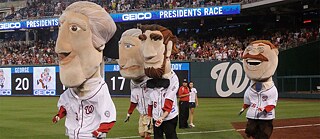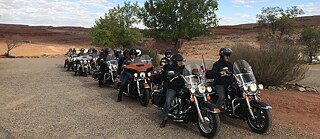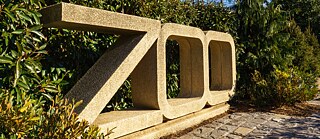Lasst die Puppen tanzen
Puppeteering from Darmstadt to D.C.
Von ihrer transatlantischen Karriere erzählt Ingrid Crepeau. Die erfolgreiche US-amerikanische Puppenspielerin und -bauerin aus Washington, D.C. ist bekannt für die Racing Presidents des Baseballteams Washington Nationals.
Diese Folge anhören: Apple Music | Spotify | Download
Diese Folge stammt von Flawn Williams. Flawn ist technischer Leiter von THE BIG PONDER. Er lebt in Maryland und arbeitete viele Jahre für das National Public Radio. An der Georgetown University in Washington, D.C. unterrichtete er Aufnahmetechnik. Als Kind lebte er kurz in Deutschland, wo sein Vater als Soldat der US‑Army stationiert war. Mittlerweile lebt Flawn in Maryland. In diesem Podcast unterhält er sich mit Ingrid Crepeau. Das Foto zur Folge wurde von der Website LetTeddyWin.com zur Verfügung gestellt und zeigt die Racing Presidents des Baseballteams Washington Nationals.
Transkript
Flawn Williams: I’m Flawn Williams, in Washington, D.C.[RACING PRESIDENTS ANNOUNCER: “GEORGE IS OUT OF THE GATE FIRST! HERE’S TOM, ABE, AND TEDDY! TOM IS NOW IN THE LEAD, GEORGE IS IN SECOND, ABE IS IN THIRD!”]
Flawn Williams: At the baseball stadium over at the D.C. waterfront, there’s a mid-game diversion on the field. It’s a foot race, featuring ten-foot-tall body puppet heads, of four American presidents: George Washington, Thomas Jefferson, Abe Lincoln and Teddy Roosevelt.
[RACING PRESIDENTS ANNOUNCER: “THEY’RE HEADED THROUGH THE RIGHT FIELD CORNER, PASSING THE NATIONALS’ BULLPEN. WHO’S GOING TO TAKE THE WIN?”]
Flawn Williams: It’s a real race, but the Teddy Roosevelt mascot almost always loses. Meanwhile, on the other side of town, you can take the family to enjoy a musical puppet show that teaches kids in a fun way about dinosaurs.
[MICHELE SINGS VERSE OF DINOSAUR BABIES FROM DREAMOSAURUS: “YOU’VE HEARD ABOUT SHARP-TOOTH, THAT’S BIG OLD T-REX, WHOSE BREATH PROB’LY MADE A BIG STINK! OR ANKYLOSAURUS, HE WAS BUILT LIKE A TANK! SEARCHIN’ THE DESERT FOR SOMETHING TO DRINK ...”]
Flawn Williams: A creative force behind both of these events is a seasoned veteran puppeteer and puppet builder named Ingrid Crepeau. And an important milestone in Ingrid’s journey to become a puppet master happened across the Pond, in the German city of Darmstadt in the late 1950s.
Ingrid Crepeau: My Dad was in the Air Force, and we were stationed in Germany. We actually flew across the ocean in a propeller plane, with a refueling stop at the Azores. And it took seventeen hours! And we stayed in Germany for three years and flew back on a jet. So we went from the dark ages to the modern times while I was in Germany!
Flawn Williams: Ingrid arrived in Darmstadt at age eleven. And she quickly became enthralled with the town.
Ingrid Crepeau: It is the most livable, delightful city I have ever been in in my whole life. It has a Strassenbahn, and back then it was so cheap, we just went everywhere on a Strassenbahn! And it had a wonderful center of town, which just was so inviting. It had a Centerplatz with a big statue of Ludwig (Archduke Ludwig I of Hesse). So of course he was called ‘Langer Lui’. And you’d just say, “I’ll meet you at Langer Lui!”
Flawn Williams: One major draw at the Darmstadt Centerplatz was a department store which offered one very special attraction for Ingrid.
Ingrid Crepeau: It had one whole room of nothing but puppets! I was in heaven! Just to go and look at all those puppets was pretty thrilling. And then at Christmas time, the whole Centerplatz was just gorgeous, all lit up and beautiful. And in the Kaufhof they had the windows lined up, and you’d start at window one. And they would start a puppet show. Then you’d go to the next scene you’d walk to the next window, see the next scene of the puppet show, and then you’d go to the next window, and it took like four windows, and you saw a little puppet show.
Flawn Williams: Ingrid attended a school for the children of American military families in Darmstadt. And the school also hosted extracurricular events. One season they scheduled a series of puppet shows on Saturday afternoons.
Ingrid Crepeau: This puppeteer, who, I’m not sure I remember his name but I think it’s Herr Englich. I have gone back and explored who that might have been and if it was Herr Englich, he was a national treasure in the art of Kasperle, which is the German equivalent of Punch and Judy.
Flawn Williams: The Kasperle tradition in Germany, Austria and Switzerland emerged from earlier puppet show motifs in the middle of the nineteenth century. The tradition takes its name from the puppet character known as Kasper. Kasper is a sort of positive everyman, helping his friends and making jokes, while valiantly fighting stock villains such as a witch, a devil, or even a crocodile. Or, ‘auf Deutsch’, Croh-koh-DEEL!
[KASPER AND THE CROCODILE, WITH KIDS’ REACTIONS]
Flawn Williams: And Kasper’s character has persisted, from olden times right up into the age of YouTube videos. For Ingrid, back in 1950s Darmstadt, the opportunity to see Herr Englich perform was thrilling.
Ingrid Crepeau: He was doing three performances, I bought three tickets! I was gonna see it three times! Cause what could be better? And, so being twelve, and much taller than all the little kids who came to see the puppet show, I stuck out like a sore thumb I’m sure. But I loved the puppet show, and I got back in line to get back in to see the second one and, Herr Englich signaled me to come on over and talk to him, and I said, OK, why not. So I went over, and, I don’t even know if I spoke English or German, frankly, I probably spoke a mix of it with him. And he said, ‘so you like puppets,’ and I said, ‘Oh I love puppets, I think they’re wonderful, and that was a terrific puppet show.’ And he said, ‘OK, in this show you will be the chicken.’ And it was like, ‘okay’. So he took me backstage. And it was amazing, it was miraculous!
Flawn Williams: Behind the puppet stage wall, Ingrid got to see where hand puppets were placed for quick access, where sound effect noisemakers were rigged. All the tools of this puppeteer’s trade.
Ingrid Crepeau: He could get at everything with just inches from where it needed to be. And he operated things with his foot. In fact he used to call it, he said, ‘Every puppeteer wants five hands. So I have two,’ and then he pointed to his knee and he hit a bell with his knee and says, ‘So that’s hand number three.’ And then he had a foot pedal that did the, he said, ‘That’s hand number four.’ And then I can’t remember what hand number five was. But he was just a clever, clever man.
Flawn Williams: On that Saturday, Ingrid Crepeau quickly advanced from being a member of the audience, to become a cast member in what had been a one-man show. It was a great chance to learn the ropes. But she also got to teach Herr Englich a thing or two.
Ingrid Crepeau: I got to play the chicken in two different shows. The chicken was really ingenious. I have made this puppet since then. It was made out of a feather duster. And it had some kind of a springy head on it. So all you had to do was jiggle it, and it was very funny looking. And I had thought the chicken was pretty cool in the first show. Except I wasn’t quite sure whether it was a chicken or not. So when it came time for me to do the chicken, he nodded his head. I stuck the chicken up and I went, ‘Bock Bock Bock.’ Got a huge laugh. Which he hadn’t gotten in the first show. So after the show he says, ‘Was ist das Bock Bock Bock? That’s what chickens say in America?’ So I realized, he had said, ‘Clook Clook Clook.’ Which American kids didn’t get. So from then on, I was his animal translator.
Flawn Williams: So on every Saturday for the remainder of the series, Ingrid was in the audience for the first performance, and then became part of the show.
Ingrid Crepeau: I would buy one ticket, ‘cause my mother insisted I buy one ticket after all. And then see the show, so I’d know what it was about. And then watch the second two backstage. And, you know, like the second day, I did the thunderclap. Do you know what a thunderclap? It’s a big piece of metal, and you beat it with these soft mallets. And it sounds like thunder! It was really cool. So every time he would give me something to do, and between shows while waiting for the audience, he would teach me how to be a puppeteer. It was the kind of stuff that you can’t get anywhere else. It was amazing! And what he said to me was, he wasn’t going to teach me how to make a puppet that was my problem. Figure it out. But he was gonna teach me how to make a puppet breathe. And that might be a German idiom or something, he might have said it in German. Or he might have said ‘breathe life into it’ or that was the implication, to ‘bring it to life.’ And his puppets were not sophisticated. They didn’t have moving eyes, they didn’t have moving mouths. But when you were in the audience you swore they did! Because he was such a master manipulator, that his posturing with the puppet gave it such life that your imagination filled in all the rest. Filled in the mouth. Filled in the blinking eyes. And it was quite amazing.
Flawn Williams: The guidance Herr Englich passed on to Ingrid in between shows during those Saturday sessions included some very specific tips about how to make a puppet communicate.
Ingrid Crepeau: According to Herr Englich, a puppet can express all emotions if it can nod its head yes, if it can shake its head no, and then if it can tilt its head from side to side, which he called, ‘vielleicht, vielleicht, vielleicht.’ Or, ‘perhaps, perhaps, perhaps.’ And he told me to watch dogs, which was really cool. Because he said, ‘Look at a dog. When you come in the room, the dog cocks his head to one side, and what is he saying? ‘Are you interesting? Are you gonna scratch my tummy? Are you gonna give me something to eat?’ Because that’s the question look. Between those three movements, if a puppet can do that, you can get all human emotion.’ And he would show me. He would say, ‘This is sad, this is happy,’ this is, you know, and it was just a marvelous education.
Flawn Williams: But for Herr Englich, playing to an audience of American kids may have presented a challenge. These American children didn’t bring to his performance the cultural knowledge that his usual crowds of German kids would already have known from a young age. Ingrid remembers later getting to see his puppet shows with a German audience.
Ingrid Crepeau: The Kasperle tradition has a number of set story lines that progressed over a period of time. And German kids would see them throughout their lives, and practically be able to recite some of the lines with him. Once there was a song that he sang every time he came up, and the audience sang it with him. The American kids didn’t know that, but the German kids were shouting at the puppet, and doing all kinds of things that the American kids didn’t know to do. So it must have really thrown him if that was the first time he performed for American kids. But I loved it.
Flawn Williams: Ingrid’s adventure with Herr Englich in Darmstadt wasn’t her first opportunity to play with puppets. But her earlier experience had nearly soured her on the whole idea. This was when her father was stationed at Offutt Air Force Base in Omaha, Nebraska. And Ingrid was six years old.
Ingrid Crepeau: The local community center on post would have these classes all summer. So you could go and take golf lessons, tennis lessons, or swimming lessons, or this or that or the other. And so they offered puppet classes. And my mother, and her best friend Mrs. Green, signed Cag Green, my brother, and me up for puppet lessons. And so we went. And it was awful. It was the most awful thing imaginable. These GI’s, dressed in olive drab, barked at us. ‘Get in line! You’re gonna make a puppet! You’re gonna have fun!’ You know, that kind of thing. So you get in line. Somebody comes along and sticks a tube on your finger. And then you walk to the next station and they stick this glop of ugly gray bleeuch on top of the tube. And then they tell you, ‘Okay, go home, come back next week, it’ll be dry and you’ll make a puppet!’
Flawn Williams: This was not an encouraging introduction to the world of puppetry. But would it get better the next week?
Ingrid Crepeau: Usually I was the kind of kid who would have gone home and told my mother forget it, I’m not going back. But for some reason, Cag Green and my brother Dick and I went back. And my best friend Nancy was there too through this whole process. And the next Saturday it was the same thing. Somebody put the tube and the gloppy thing, it was all dry now, papier mâché, on my finger, and then we went to a painting station and somebody painted it white. Then we went to the next station and they said, ‘What do you want to make?’ And I’m sure I said nothing, because they were rude and ugly people. I didn’t like them. So they just painted it [laughs] whatever it was! It looked like a clown. But anybody who said nothing, or didn’t know what they were making, they got a clown. My older brother picked Davy Crockett. After the faces were all painted on, we sat around and played games. And then they, the paint was dry and they said, ‘Take your heads home and have the mothers make the costumes!’
Flawn Williams: It sounds like week two was almost as bad as week one. Would the third visit rescue Ingrid from this painful bit of summer camp blues?
Ingrid Crepeau: Cag Green’s mother didn’t sew. So my mother made Cag’s and my clown costume. And she made the most exquisite, gorgeous Davy Crockett costume you’ve ever seen in your life. She took an old piece of fur off of a parka, and made a coonskin cap, and my father hand-carved a musket, I mean this was just the best puppet you’ve ever seen in your life. With a hideous head! But the costume was just breathtaking. So we took them all back the next week. Nancy and I and Cag all had clowns. And my brother had Davy Crockett of course. So we were in line, and the mean ugly man barked at us, and herded the three clowns back behind this puppet booth. And said, ‘Now! Put on a puppet show!’ This guy had no clue how to deal with children. He was clueless.
Flawn Williams: But for Ingrid that day, out of stage fright came an inspiration.
Ingrid Crepeau: Here I am, a painfully shy child. Something miraculously came over me. And I stuck that clown up into the rectangle that’s the puppet booth. And my clown said, ‘I am Davy Crockett! King of the wild frontier! And this is my best friend, Fred!’ And I nudged — Nancy was Fred — and say, hi I’m Fred. And then I said, ‘Look out Fred! Here comes a very scary bear!’ And I told Cag, ‘Hey Cag, growl!’ So he stuck his clown up and growled. The audience is going bananas! They’re laughing themselves silly. And the more they laughed, the more outrageous I got! And Cag and Nancy were just going along with the joke. And we did one of those hand wrestles, you know, RRRRRRRR, back and forth until I kicked Cag and said, ‘I win! Don’t forget!’ [laughs] And then Davy Crockett said, ‘I saved you Fred! The End!’ And uproar! It was like uproar of laughter and clapping. And the mean man made us come out and take a big bow. And I don’t remember the rest of the day. I just floated like, my first performance was a huge success! So that’s what got me hooked on puppets.
Flawn Williams: After this early taste of applause, and her later time apprenticing with Herr Englich in Darmstadt, Ingrid Crepeau and her family returned to America. Her passion for puppets continued there.
Ingrid Crepeau: I got two friends in ninth grade, and we started a puppet company. And we did it all through high school. We performed at libraries and malls, those were our gigs. And we actually made a little bit of money. But mostly it was fun.
Flawn Williams: Ingrid needed a puppet stage to do those performances. And thanks to some support from her parents, she was able to build one. But that cooperation came with a condition.
Ingrid Crepeau: My mom was great. She used to let any one of us take over the house. I mean literally, take over the house. But she made you sign a contract. You’d start on this day. And you’d end on this day. And she did that because she knew too many people who started things and didn’t finish them. And she wanted this to be an important life lesson. So I signed a contract that I would build this puppet stage. We had no basement, no garage. My father and I built it in the living room and dining room. But my kid brother remembers having dinner under the dining room table, because there was all this puppet stuff on top of it. I don’t remember doing that, but it doesn’t surprise me!
Flawn Williams: Later, Ingrid and her puppet inspirations wound up in Washington, D.C. And through connections in the theater community, she got involved with Dinorock, a performing company that would become a Washington institution.
Ingrid Crepeau: Michele Valeri was a local artist. She and I had eleven friends in common, and didn’t know each other. She was asked by the Smithsonian to take her first Dinosaur record, to turn it into something theatrical that could be done at the Discovery Theater. She had done a concert of it, and it was wildly successful at the Smithsonian, so that’s why they asked her to do the theatrical. So she asked all the puppeteers she knew if they would make her something big. And every one of them said ‘If you want big, you have to see Ingrid, and what? You don’t know Ingrid? No, you’ve got to know Ingrid!’ We talked, and I listened to this Dinosaur record. Absolutely fell in love with it. And all she wanted was a big T-Rex foot, and an egg, and I don’t know, a couple of little things. But I heard this record, and I said, oh no, she’s gotta have way more than that! So I took her out to dinner, and I gave her a proposition she just couldn’t pass up. I told her if she let me do it, I would make a dinosaur that small children (like three and under) would believe they had met a real, live dinosaur. Well, who could pass that up?
[“DINOSAURS FOREVER” FROM THE DREAMOSAURUS CD]
Flawn Williams: So the first Dinorock theatrical event came together. It turned out to be a hit with the younger set. But Ingrid’s ideas about realistic, non-scary dinosaur puppets would require some tweaking along the way.
Ingrid Crepeau: The very first Dinosaur show we did at the Smithsonian, I had created a sixteen-foot tall long-necked dinosaur. The set was, like, trying to be a Smithsonian exhibit about dinosaurs. And I thought it would be really funny if the dinosaur stood there as if it was a model — with me hiding of course, very still, not move —, and then at some point in the show she would spring to life. Well, at some point in the show she sprang to life. Uh small children wet their pants, went running and screaming. It was the most embarrassing, awful moment. So, after that, we had the house manager for the Smithsonian say, ‘Uh, I want to introduce you to a friend of mine. She’s gonna be in the show, and she’s very tall, so look up over there. Dinah, would you come out?’ And Dinah would come out and go, ‘Oh hi everybody! I’m gonna stand here and pretend to be a big dummy. So don’t tell anybody that I’m real, okay?’ And then it was okay. Nobody ever was scared after that. But surprising young children is not a good idea. That was the big takeaway from that lesson.
Flawn Williams: Over the years, Dinorock shows have become a rite of passage for generations of children in Washington and elsewhere. And more shows have joined the rotating repertory of Ingrid and Michele’s theater company.
Ingrid Crepeau: We have two dinosaur shows at the moment: Dinosaur Babies, and Dinosaur Book of World Records, where we talk about the tallest and the shortest and that kind of stuff. And a show called Junkyard Pirates which is about recycling and saving the earth. And all the puppets are made out of stuff either from the trash or from the secondhand store, and things like that.
Flawn Williams: In all of these shows, there’s one constant. Ingrid is either behind a set manipulating hand puppets, or she’s performing inside a large body puppet. Michele Valeri is out front.
Ingrid Crepeau: She’s the intermediary. Puppets and clowns and things can be terrifying to very young children. So she proves to the children that she’s not going to be eaten so maybe they won’t be eaten either. And we’ve found that to be a very helpful thing. We did a show yesterday. And this little girl — I guess it’s a show where kids watch me get into the puppets. We make no hiding. They all know that I’m doing the puppets if they want to know! But she didn’t want to know. Watching me get into it, made it not scary. But once I was in it, it was completely real to her. And she believed it was real, so after the show, her mother said, ‘I’m trying to tell my daughter that they’re not dinosaurs, that they’re puppets.’ She wouldn’t buy it. She had seen real dinosaurs. And that kind of thing has happened many times.
Flawn Williams: The success of these shows led indirectly to another puppet adventure for Ingrid. At a reception following a Dinorock performance on Capitol Hill, she got to see gigantic body puppets. Lots of them and all of them affiliated with the Washington area’s professional sports teams.
Ingrid Crepeau: At this party, Teddy Roosevelt of the Racing Presidents was there. Talon, the mascot for the D.C. United was there, and the mascot for the basketball team was there. And — Teddy — I had never seen him before. I’d been to baseball games but before the Racing Presidents. And, I was just enthralled with this gigantic thing. So Michele went up to the mascot coordinator and said, ‘See that lady over there?’ — pointing at me — ‘She made all those dinosaurs that you saw, and she’d like to take a look at Teddy.’ I’m from Minnesota, I would never go up to somebody and ask them these things. So I went up, and I looked inside and I said, ‘Oh dear! This is really broken! Whoever did this didn’t re-temper the aluminum after they’d drilled the holes!’ And the mascot coordinator said, ‘You know about this stuff?’ — ‘Yeah, yeah’. ’Give me a card! Give me a couple of cards!’
[CONCLUSION OF PRESIDENTS FOOTRACE: “ABE IS NOW MOVING INTO THE LEAD ON THE OUTSIDE. TOM’S ON THE INSIDE, TEDDY IS THIRD, GEORGE IS FOURTH, AND IT LOOKS LIKE THE WINNER’S GOING TO BE … ABE!!!”]
Flawn Williams: After that chance meeting, Ingrid was soon helping to repair, improve, and re-costume the four Racing Presidents. These ten-foot-high body puppets run a footrace in the middle of the fourth inning at every Washington Nationals baseball home game.
Ingrid Crepeau: I come from a family of engineers. I come from a family of people that make things. So it wasn’t foreign to me to know about tempering aluminum, and using aircraft aluminum not the stuff they sell at the hardware store. And what was happening was that these puppets were supposed to be temporary. It’s not really the fault of the guy who made them in New York. And then they were so popular, they wanted more and more and more! And in the way he had built them, not only did the aluminum break, but it was poking through the head of the puppet! So I figured the first thing I had to do was create a structure like snowshoes. Everything you learn in life, you can use! If a pole wasn’t just against the head, but against something that would make the weight evenly distributed over the whole dome of the head, then nothing would ever poke through! My frames hold up pretty well. Sometimes the bolts in the frames break, but the frames themselves don’t break.
Flawn Williams: Ingrid’s work with Michele Valeri in the Dinorock shows includes designing, building, and operating huge body puppets, plus singing and acting out the puppets’ parts. But when you see the Racing Presidents run their races at the ballpark, Ingrid is not one of the people inside the puppets. She tried on Teddy Roosevelt at her home workshop, just to see how it would feel.
Ingrid Crepeau: The very first time I had Teddy over here, I had to make sure that what I was doing would work. I put him on. And I put him on for ten minutes. And I said, ‘I don’t know how they do this. I can’t hold him any longer than this, much less run!’ So no, this is superhuman.
Flawn Williams: And when you see the Racing Presidents in action, it becomes clear pretty quickly why some occasional repairs might be needed.
Ingrid Crepeau: They run into each other, they run into themselves, they just fall down on purpose! I made Star Wars Day costumes for these giant Presidents, they’re Star Wars characters! And so on top of being — Thomas Jefferson is twelve feet tall — he’s got almost fifty pounds of weight, the performer, over his head! And then they got on bicycles! And they rode around on the dirt, in the stadium! It’s like, ‘Oh, can’t make it any harder, could you?’ But those guys are such athletes! And they’re so into what they do, they love this stuff!
Flawn Williams: And Ingrid notes that there’s one major difference between the talking dinosaur puppets she designs and inhabits for the Dinorock shows, and the sports mascots she helps to create:
Ingrid Crepeau: Mascots have wonderful mascot rules among which is they can’t talk. They do not talk. But they do communicate! It’s just like Herr Englich, they communicate with posturing, and they make themselves understood.
Flawn Williams: And sixty years after her pre-teen apprenticeship in Darmstadt with the German master puppeteer Herr Englich, Ingrid Crepeau is still applying his lessons to delight American audiences!
Ingrid Crepeau: After those few weeks with Herr Englich, I said ‘That’s it, I’m gonna be a puppeteer.’ And I never deviated. Anybody asked me what I was gonna be — puppeteer, puppeteer, so ... and I am!
Flawn Williams: For THE BIG POND, I’m Flawn Williams.







